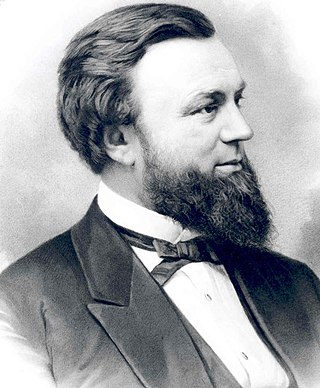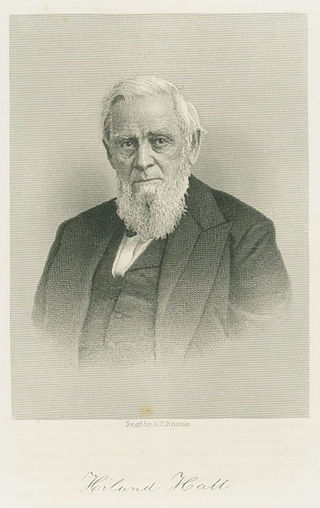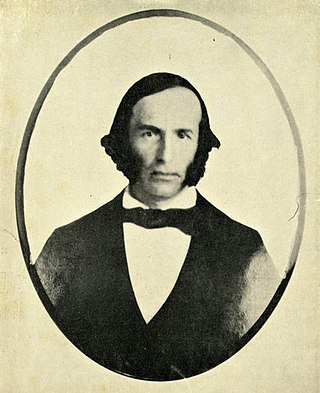Related Research Articles

Frederick H. Billings was an American lawyer, financier, and politician. He is known for his legal work on land claims during the early years of California's statehood and his presidency of the Northern Pacific Railway from 1879 to 1881.

The Park–McCullough Historic Governor's Mansion is one of the best-preserved Victorian mansions in New England. It is a thirty-five room mansion, set on 200 acres of grounds, and located off Vermont Route 67A in North Bennington, Vermont, USA.
The Department of the Pacific or Pacific Department was a major command (Department) of the United States Army from 1853 to 1858. It replaced the Pacific Division, and was itself replaced by the Department of California and the Department of Oregon.

Hiland Hall was an American lawyer and politician who served as 25th governor of Vermont and a United States representative.
Zachariah "Zach" Montgomery was a publisher, lawyer, politician, and author, particularly known for his skills as an orator.

Nicasio Creek is an 11.9-mile-long (19.2 km) stream in Marin County, California, United States and is the primary tributary of Lagunitas Creek, which flows, in turn, into Tomales Bay, and the Pacific Ocean. The Nicasio Reservoir, formed in 1961 by Seeger Dam, is located on this stream.
Rancho Nicasio was a Mexican land grant of 56,807 acres (230 km2) granted to the Coast Miwok indigenous people in 1835, located in the present-day Marin County, California, a tract of land that stretched from San Geronimo to Tomales Bay. Today, Nicasio, California is at the heart of this location.

The following timeline traces the territorial evolution of California, the thirty-first state admitted to the United States of America, including the process of removing Indigenous Peoples from their native lands, or restricting them to reservations.
Rancho Cañada de Pogolimi was a 8,781.81-acre (35.5387 km2) Mexican land grant in present-day Sonoma County, California given in 1844 by Governor Manuel Micheltorena to María Antonia Cazares, widow of James Dawson. The grant encompasses present-day Bloomfield.
Rancho Las Mariposas was a 44,387-acre (179.63 km2) Mexican land grant in Alta California, located in present-day Mariposa County, California.
Rancho Río de los Americanos was a 35,521-acre (143.75 km2) Mexican land grant in present-day Sacramento County, California given in 1844 by Governor Manuel Micheltorena to William Leidesdorff (1810–1848). The grant takes its name from Río de los Americanos, the name of the American River during the Mexican-rule era. The grant originally consisted of 8 square leagues and extended from the eastern border of John Sutter's New Helvetia 4 leagues along the south bank of the American River, to the eastern end of present-day Folsom, and included present-day cities of Rancho Cordova and Folsom.

Rancho Thompson was a 35,533-acre (143.80 km2) Mexican land grant in present-day San Joaquin County and Stanislaus County, California given in 1846 by Governor Pío Pico to Alpheus Basil Thompson. The rectangular grant was 2 leagues along both sides of the Stanislaus River by 4 leagues – mostly north of the river. The grant encompassed present-day Riverbank and Oakdale.
Rancho Novato was a 8,871-acre (35.90 km2) Mexican land grant in present day Marin County, California given in 1839 by Governor Juan Alvarado to Fernando Feliz. The grant extended along San Pablo Bay, from Black Point to Rancho San Jose, and included the land that now encompasses the city of Novato.

Trenor William Park was an American lawyer, political figure, and businessman. He was most notable as a founder of the Republican Party in California, and for his Republican leadership roles in Vermont, including member of the Republican National Committee and the Vermont House of Representatives.

Rancho San Carlos de Jonata was a 26,634-acre (107.78 km2) Mexican land grant in present-day Santa Barbara County, California given in 1845 by Governor Pío Pico to Joaquín Carrillo and Jose Maria Covarrubias. The grant was west of Mission Santa Inés in the Santa Ynez Valley, and extended north from the Santa Ynez River along Zaca Creek. The grant encompasses present-day Solvang and Buellton.

The Department of California was an administrative department of the United States Army. The Department was created in 1858, replacing the original Department of the Pacific, and it was ended by the reorganizations of the Henry L. Stimson Plan implemented in February 1913. As with the preceding organization, headquarters were in San Francisco. Its creation was authorized by General Orders, No. 10, of the War Department, Adjutant-General's Office, September 13, 1858.
Rancho San Juan was a 19,983-acre (80.87 km2) Mexican land grant in present-day Sacramento County, California given in 1844 by Governor Manuel Micheltorena to Joel P. Dedmond. The grant extended east of Captain Eliab Grimes Rancho Del Paso along the north bank of the American River, across from William Leidesdorff's Rancho Rio de los Americanos, and encompassed present-day Orangevale, Fair Oaks and most of Carmichael.
Rancho San Diego Island was a 4,185-acre (16.94 km2) Mexican land grant in present day San Diego County, California given in 1846 by Governor Pío Pico to Pedro C. Carrillo. The grant consisted of the strip of land lying between the San Diego Bay and the Pacific Ocean, which was initially referred to as the Island or Peninsula of San Diego, and which included present day Coronado and North Island.

Oscar Lovell Shafter was an American attorney and Associate Justice of the Supreme Court of California from January 2, 1864, to December 11, 1867.
References
- ↑ Guide to the Halleck, Peachy & Billings Records, 1852-1867
- ↑ Leonard Pitt, Ramon A. Gutierrez, 1999,Decline of the Californios: A Social History of the Spanish-Speaking Californias, 1846-1890, University of California Press, ISBN 978-0-520-21958-8
- ↑ Site of The Montgomery Block (Landmark 80)
- ↑ Inventory of the Halleck, Peachy & Billings Collection, 1837-1861
- ↑ Archibald C. Peachy
- ↑ Frederick Billings Dead, New York Times, October 1, 1890
- ↑ Trenor WilliamPark Archived 2011-07-16 at the Wayback Machine by Lewis Cass Aldrich, 1889, History of Bennington County, VT
- ↑ Trenor W. Park Dead, New York Times, December 21, 1882